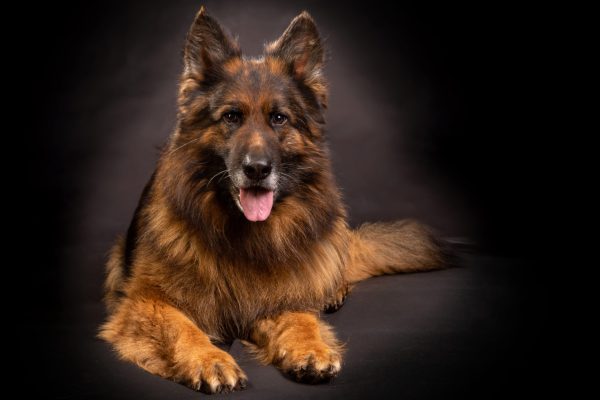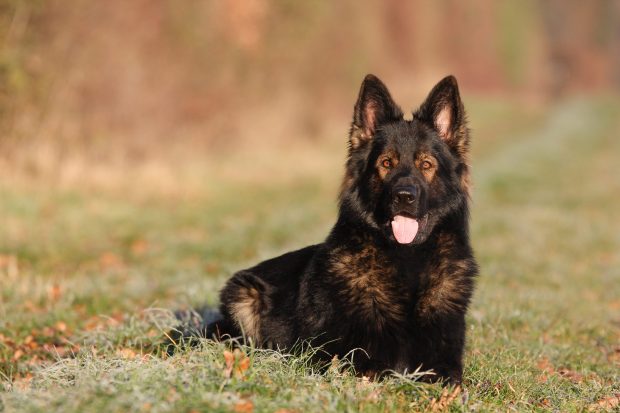
While one may find long coated German Shepherd Dogs listed on the AKC’s Marketplace, the AKC breed standard writes that the ideal dog has a double coat of medium length. Indeed, among coat faults is a “too long outer coat.”
The “Father of Modern Shepherds,” Max Von Stephanitz, is said to have disliked long-haired shepherds, in part because he felt that such a coat was not especially helpful in a working dog because it lacked an undercoat, and was more trouble than it was worth. In fact, the Breed Survey Scheme in Germany in 1922 removed the rough-coated and shaggy-coated Shepherds out of the breeding pool because of instructions from von Stephanitz (long coats with an undercoat, however, were still allowed to be exhibited at shows).
For a long time, then, long-haired Shepherds weren’t seen in competition. The coat length, recessive in modern shepherds, is found in approximately 10% of the breed, but the real reason one didn’t see long coated Shepherds in a GSD ring is because breed standards essentially prohibited them.
This has changed in some places.
In 2010, the Verein für deutsche Schäferhunde (Society for German Shepherd Dogs) or SV founded by Max von Stephanitz and Arthur Meyer in 1899 amended the standard which reversed the old rule by allowing “long coats with undercoats” to be exhibited once more. In the UK, the Kennel Club also officially recognized the coat length in the breed standard. Its standard reads:
Coat: Two separate varieties of coat:
Outer coat consisting of straight, hard, close-lying hair as dense as possible; thick undercoat. Hair on head, ears, front of legs, paws and toes short; on neck, longer and thicker; in some males forming slight ruff. Hair longer on back of legs as far down as pasterns and hocks, forming fairly thick trousers on hindquarters. Mole-type coats are undesirable.
In long coats, outer coat longer, not always straight and frequently not lying close and flat to the body. Thick undercoat. Coat distinctly longer inside and behind the ears, forming moderate tufts. Longer hair on the back of the forelegs, through to the loins, and dense feathering on the hindlegs. Tail bushy with light feathering underneath.
Dogs Australia, the body in Australia responsible for Registered Purebred dogs, also includes a longer coat. Its standard reads:
The German Shepherd Dog is bred in the coat varieties: stock coat (normal) and long stock coat, both with undercoat.
Stock Coat (normal):
The top coat should be as dense as possible, straight, harsh and close lying. It should be short on the head, including the inside of the ears, the front of the legs, and on the feet and toes; it is a little longer and heavily coated on the neck. The hair lengthens on the back of the legs to the pasterns or hock joints; and on the back of the thighs it forms moderate breeching
Long Stock Coat (Long Coat):
The top coat should be long, soft and not close fitting, with feathering on the ears and legs, bushy breeches and bushy tail forming flags below. It should be short on the head including the inside of the ears, the front side of the legs, on the feet and toes, it is longer and heavily coated on the neck, almost forming a mane. The hair lengthens on the back of the legs to the pasterns or hock joints; and on the back of the thighs it forms distinct breeching.
The FCI, the international federation of national kennel clubs, also accommodates the long coat. From the standard (which includes photographs):

Coated German Shepherd Dog
By Sebastian Wolf
Coat Hair texture Hair: The German Shepherd Dog is bred in the hair varieties double coat and long and harsh outer coat – both with undercoat. Double coat: The guard hair should be as dense as possible, particularly harsh and close fitting: short on the head, including the inside of the ears, short on the front side of the legs, paws and toes, some-what longer and more strongly covered in hair on the neck. On the back side of the legs the hair extends to the carpal joint or the hock; it forms moderate ‘trousers’ on the back side of the haunches.
Long and harsh outer coat: The guard hair should be long, soft and not close fitting, with tufts on the ears and legs, bushy trousers and bushy tail with downward formation of tuft. Short on the head, including the inside of the ears, on the front side of the legs, on the paws and toes, somewhat longer and more strongly covered in hair on the neck, almost forming a mane.
For now, the AKC standard calls for a medium length coat, while the Canadian Kennel Club standard reads, “Coat: The breed’s outer coat is dense, straight, short and close. There is a soft undercoat.”
To our knowledge, both parents must carry the long coated gene for it to manifest in their puppies, and even then, it will only appear some of the time. Two medium or short-coated GSDs that carry the gene can have a litter with no long-haired puppies, or their litter may have two or three. It’s rare for an entire litter to have this recessive gene turned on since parents also carry the dominant short hair genes, which, when combined, are much more likely to manifest than the recessive short hair trait.
